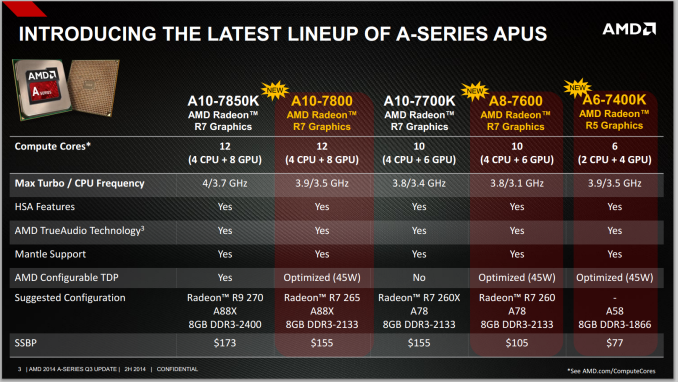AMD A10-7800 Review: Testing the A10 65W Kaveri
by Ian Cutress on July 31, 2014 8:00 AM ESTConclusions
When AMD launched their 95W Kaveri APUs and we had the opportunity to test the top A10 model, it offered some of the best integrated graphics performance for a desktop we had seen. The fact that the die is partitioned such that more than 50% of it is for the graphics, along with expanding HSA and OpenCL support, means that for applications that can be computationally enhanced by integrated graphics, AMD has the edge for the single chip solution.
In our testing, because the A10-7800 shares the same processor graphics configuration and speed as the A10-7850K, results were fairly similar despite a +100 MHz advantage to the A10-7850K. This means that, at stock, AMD is offering a similar CPU for $18 less.
If we remove the price from the equation, the biggest contender for the title of ‘best processor graphics’ is Intel’s Iris Pro. The upside of AMD’s Kaveri at the minute is not only the price, but also the form factor – Iris Pro is only available as a soldered on (BGA) CPU at this point in time whereas Kaveri is in both soldered and socketed form. Also, Iris Pro relies on an extra L4 cache, which adds size to the CPU package as well as cost and power consumption. News from Intel might change that with Broadwell, as back in May an announcement regarding a socketed, overclockable Iris Pro CPU would be coming to market. We have not the slightest clue when AMD will have this competition, but it looks good for AMD given that recent reports suggest that Broadwell for the desktop may be delayed beyond the expected launch of 14nm Core-M in Q1 2015.
In that respect, it may give AMD some time to prepare for their new 64-bit x86 architecture, or give AMD another chance to leap forward in with their Carrizo APUs (still based on modules and GCN) if they are launched in 2015.
Back to the A10-7800 reviewed today, and as it stands it is the most cost effective processor graphics solution available. Here is all the speed of the A10-7850K for $18 cheaper, and more performance than the A8-7600. The 45W configurable TDP makes it even more enticing as a lower power consumption part.
The only issue users might come across is the speed and feel when running single threaded tasks that do not utilise OpenCL or HSA – our web benchmarks put the AMD APUs behind many of our 55W Intel samples for the last couple of generations. But for anything that uses OpenCL as an accelerant, such as the software on which PCMark8 is based or anything compute, AMD comes out on top.











147 Comments
View All Comments
r3loaded - Thursday, July 31, 2014 - link
Conclusion: Unless you absolutely need fast, integrated graphics, a cheap Haswell will stick kick AMD's ass.Creig - Thursday, July 31, 2014 - link
What Haswell system will keep up with Kaveri at the same price point?Anonymous Blowhard - Thursday, July 31, 2014 - link
A10-7800 - $150FM2+ - $50 (maybe a Hudson D2 if you're lucky)
G3220 - $60
LGA1150 H87 mATX - $42
R7 260X - $100
Sorry, that won't "keep up" with Kaveri - it will WRECK it.
Flunk - Thursday, July 31, 2014 - link
You're right, blowhard. It would crush it, except in CPU multithreaded benchmarks... But who cares about that?The funniest thing about this build is that AMD products still soak up the majority of the budget.
silverblue - Thursday, July 31, 2014 - link
There are some instances that having a 2C/2T CPU will begin to make less and less sense as time goes on; for example, BF4 performance is reduced compared to the i3s and especially so compared to the i5s/i7s, but whilst this may become more and more common as time goes on with newer engines, there's still plenty of titles that a Pentium will shine in. However, will the frame latencies be acceptable? The following article does pose some interesting questions...http://www.eurogamer.net/articles/digitalfoundry-2...
FriendlyUser - Thursday, July 31, 2014 - link
I think you are right. The 4-core processors are way more future-proof. Single-thread performance has been very important but has also stagnated. Plus, we all know that the consoles are multi-core machines and game programmers will have to work with well-threaded engines.silverblue - Saturday, August 2, 2014 - link
It's one of those situations where the more threaded an engine becomes, the more Kaveri should outperform Piledriver due to not having the decoder switching between threads all the time. Piledriver's saving grace is clock speeds, but if AMD was to be able to release a Kaveri refresh, I'm sure they'd have mastered the 28nm process by then and be able to get a bit more speed out for the same power.Computer Bottleneck - Thursday, July 31, 2014 - link
I liked article a lot. The author makes a good point about cpu to gpu balance.Therefore, if frame time variance will be examined in the future with 2C/2T processors I would hope appropriately sized discrete cards would be used. Maybe R7 260X or smaller (at suitably low resolution and detail settings) is a good starting point for testing 2C/2T processors in the future?
kmmatney - Thursday, July 31, 2014 - link
If you lower the budget (take out the graphics card) you can get an A8 6600K + MB for $99.99 at Microcenter. For light gaming this will way outperform the Intel solution with IGP, anf be plenty good enough for all other uses.kmmatney - Thursday, July 31, 2014 - link
I'll admit - if you don't have a local Microcenter near you (I have one in Denver) then it's harder to go AMD.